The Influence of Crystals on Mental Well-Being
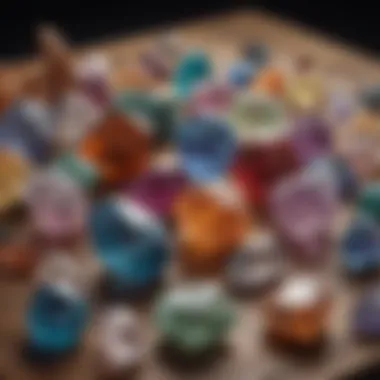
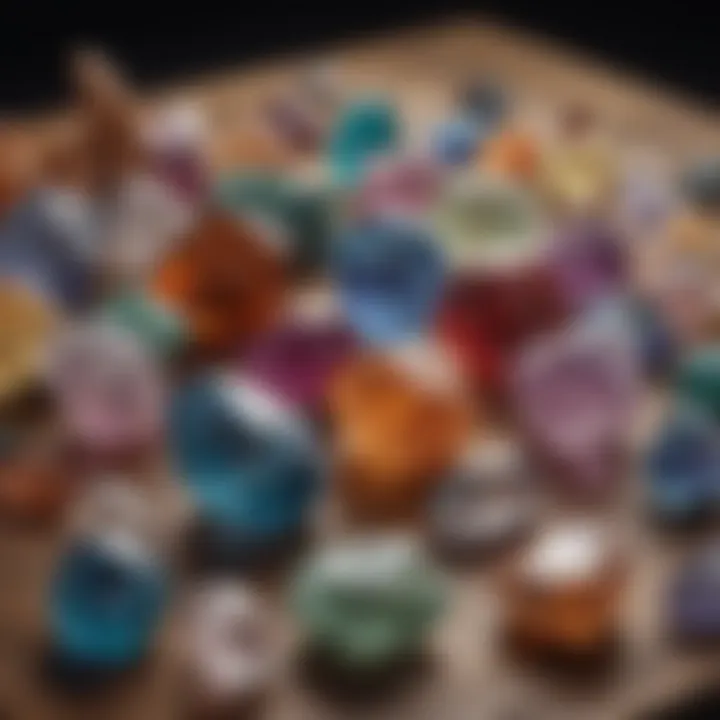
Intro
The role of crystals in mental health practices has garnered increasing interest in recent years, with both enthusiasts and skeptics pondering their potential benefits. It’s a topic steeped in history yet alive and kicking in contemporary wellness discussions. From ancient civilizations to modern therapy rooms, gemstones have been cherished not merely for their beauty but also for their believed influence over emotional and psychological states.
Taking a closer look, this exploration will chart the landscape of how crystals are perceived, their properties, and the science—or lack thereof—behind their usage in mental health strategies. It doesn't merely skim the surface; rather, it dives deep into the very essence of what crystals represent in our lives today.
In the paragraphs that follow, we will unpack definitions, delve into classification, and sift through the vibrancies of properties and applications related to crystals. This is not just an analysis; it’s a conversation about an evolving narrative in mental wellness. Crystals, with their myriad hues and textures, aren’t just pretty stones; they are entities that many believe can help heal the mind and spirit.
Let’s embark on this journey together.
Intro to Crystals and Mental Health
The relationship between crystals and mental health is both ancient and contemporary, providing a rich tapestry of beliefs, practices, and experiences across cultures and epochs. Crystals are often seen not just as mere geological formations, but as powerful symbols that can influence emotional states, lend support in stressful times, and enhance overall well-being. As more individuals search for holistic approaches to improving mental health, the interest in how these stones can be integrated into wellness practices has grown substantially.
In this article, we will delve deep into various facets concerning crystals and their perceived impact on mental well-being. This includes exploring their historical context, examining their physical and metaphysical properties, and discussing their modern applications in therapeutic settings. The aim is to paint a detailed picture that situates crystals within the broader landscape of mental health practices today.
Defining Crystals
Crystals are solid materials with atoms arranged in an orderly repeating pattern. This symmetry within their structure is what grants crystals their beauty and unique properties. Different types of crystals, such as quartz, amethyst, and citrine, all have distinct characteristics formed by their elemental make-up and the conditions under which they were created deep within the Earth's crust.
These natural specimens have captured human imagination and curiosity for centuries, being used both in practical contexts, like jewelry making, and in spiritual or healing practices. In the realm of mental health, many believe that crystals can resonate with certain emotions or energies that, in turn, can aid in emotional healing and mental clarity.
Understanding Mental Health
Mental health encompasses our emotional, psychological, and social well-being. It influences how we think, feel, and act. Factors contributing to mental health can range from genetics to experiences and environmental elements. In today’s fast-paced world, the need for mental health support has surged, urging many to explore diverse methods for maintaining or improving emotional stability.
Crystals, with their centuries-old associations with healing and balance, have emerged as one avenue for support. Many practitioners emphasize the role of intention and mindfulness while working with crystals in enhancing mental clarity and emotional resilience. It’s believed that specific stones can aid in reducing stress, mitigating anxiety, or uplifting one's mood, thus playing a vital role in holistic health approaches.
"The potential of crystals to influence our mental states offers a fascinating glimpse into the interplay between natural elements and emotional health."
In summary, examining crystals through the lens of mental health opens a dialogue about the significant impact of tangible elements on our intangible experiences. This discourse is not merely academic; it's a living topic that resonates with many seeking solace and harmony in their lives.
Historical Perspectives on Crystals
Exploring the historical perspectives on crystals serves as a crucial foundation for understanding their influence on mental health today. For many, crystals are more than just pretty rocks; they embody a rich tapestry of cultural significance and ancient practices. Over the centuries, people have harnessed the unique qualities of crystals, believing them to hold the power to heal and promote well-being. By shedding light on historical uses and cultural significance, we can better appreciate how these stones are interwoven into the fabric of mental health practices across various societies.
Ancient Uses of Gemstones
From the ancient Egyptians to the Greeks, gemstones have found a prominent place in rituals and daily life. Each stone was often ascribed special powers. For instance, the Egyptians, known for their reverence for turquoise, believed it to be a symbol of protection, promoting good health and warding off evil spirits. Similarly, lapis lazuli, a deep blue stone, was associated with the goddess Isis, representing wisdom and friendship. Its use in burial tombs indicates that they valued its metaphysical properties for the afterlife as well.
The ancient Greeks were not shy about their admiration for crystals either. They referred to amethyst - from the Greek word "amethystos," meaning "sober" - as a stone that could prevent drunkenness. Today, many turn to amethyst for emotional balance and clarity, showing how some beliefs have endured through the ages. These historical usages exemplify how deeply embedded crystals are in our collective psyche.
Cultural Significance in Different Societies
Crystals don’t just have a storied past in Western cultures; their significance spans the globe. In many Native American traditions, crystals are revered as sacred objects. They are often used in healing ceremonies to connect the spirit and physical worlds. For example, the use of crystal skulls by some tribes is seen as a means to access spiritual wisdom.
Across the ocean, in Asian cultures, jade has long been considered a symbol of serenity and protection. It is believed to bring harmony to one’s life and has been used in both ornamental and healing practices. No culture, it seems, has overlooked the potential of these natural wonders to impact emotional and spiritual well-being.
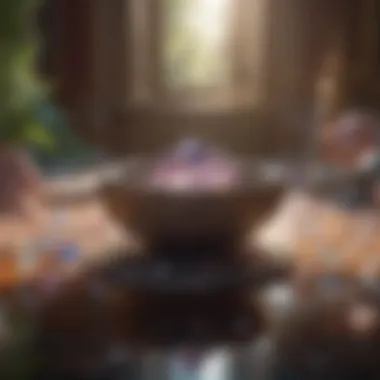

"Crystals are the Earth's natural libraries, containing records of centuries of human experience and wisdom."
In modern times, the resurgence of interest in holistic health and wellness has brought crystals back into the spotlight. People are integrating ancient beliefs into contemporary practices, making it essential to consider this historical context.
To wrap it up, the historical perspectives on crystals enrich the narrative of their role in mental health today. As we consistently find ourselves drawn to these vibrant stones, knowing their backgrounds enables us to harness their potential more effectively. Delving into the past reveals a lineage full of insight and significance that proves to be as relevant now as it was centuries ago.
Properties of Crystals
The topic of crystal properties profoundly influences the discourse around their impact on mental health. Understanding both the physical and metaphysical attributes of crystals allows us to explore their potential benefits in emotional well-being. Through proper knowledge of these properties, individuals can make informed choices about which stones might best suit their needs. The assessment of these properties isn't just a simple curiosity; it carries implications for how effectively someone might utilize crystals in their daily practices.
Physical Properties
Physical properties of crystals are the tangible characteristics that define their structure and appearance. This includes parameters like hardness, luster, color, and specific gravity. Each crystal possesses a unique combination of these traits, making them identifiable and sometimes giving insight into their perceived effects on the mind and body.
For instance, consider quartz. It's known for its clarity and solid structure. Quartz is a hard stone, ranking seven on the Mohs scale; it is resilient and can be used in various settings without quickly chipping or breaking. This durability parallels the mental strength that many associate with it. People often use clear quartz in moments of deep meditation or clarity-seeking, emphasizing its role as a mental fortifier.
When selecting crystals for emotional healing, it's crucial to pay attention to these physical properties. Different colors can correspond with different emotions; for example, blue stones like lapis lazuli are often linked to calmness, while red stones like garnet might evoke feelings of passion. Being aware of these qualities can help individuals align their choices with their mental health goals.
Metaphysical Properties
Metaphysical properties delve beyond what is visible. These attributes are often the subject of debate and personal belief. Crystals are believed to harbor energies that can influence emotional states, promote healing, or even enhance intuition. People who incorporate these stones into their lives often talk about how they're drawn to certain crystals due to a perceived connection.
For example, amethyst is frequently cited for its reputed calming effects. Many practitioners suggest that holding or wearing an amethyst can help alleviate anxiety and promote restful sleep. The belief here is that the stone’s energy interacts with the user's aura, creating a shielding effect surrounding their mental state. This interaction aligns with the idea that crystals can serve as allies in managing stress and mental fatigue.
Despite the skepticism that exists regarding these metaphysical claims, there is a notable community of gemstone enthusiasts who swear by the emotional benefits of engaging with these stones. It’s often said that the exploration of these metaphysical properties can be as personal as it is informative, allowing for a customized mental health strategy.
Energy Vibration Theories
Energy vibration theories propose that everything in the universe, including crystals, emits a specific frequency. Proponents believe that these vibrations can interact with the human energy field, or aura, offering both healing and alignment with mental objectives. Essentially, each crystal vibrates at its own unique frequency based on its molecular structure.
This concept isn't solely metaphysical; quantum physics touches on similar ideas, suggesting that matter is fundamentally energetic. People who practice crystal healing often discuss how particular stones are employed to elevate one’s vibration, counteracting negative energy and enhancing emotional clarity.
Certain gemstones like selenite and citrine are believed to have high vibrational frequency. Selenite, in particular, is often used to cleanse other stones, as it's thought to resonate with pure energy and can help reset the frequency of more chaotic stones. Many individuals employ selenite in their spaces to create a serene environment, believing it encourages tranquility and focus.
"Crystals are not just pretty rocks; they are tangible anchors of energy in an often chaotic world."
The interplay of energy vibrations raises intriguing possibilities for those seeking alternatives in emotional regulation and mental well-being. By recognizing and understanding these energy dynamics, individuals might better harness the healing potential of crystals in their lives.
Crystals and Emotional Healing
Crystals have stood the test of time as tools not just for adornment, but as instruments of emotional healing. This section delves into how these stones are perceived to play a role in supporting mental health, offering insights for those interested in enhancing their emotional well-being through non-traditional means. By understanding how crystals are thought to facilitate healing, we can better appreciate their potential benefits and applications.
How Crystals Can Alleviate Stress
One of the most talked-about benefits of crystals is their supposed ability to alleviate stress. A lot of folks believe that certain crystals, like amethyst and rose quartz, can help diffuse tension and promote relaxation. The idea rests on an interesting premise: that the vibrational energy of these stones can influence our own energies, leading to a calmer state of mind.
Simple practices often involve holding a crystal in hand or placing it on a charged area of the body. For example, having an amethyst nearby during a stressful day could centrate one’s thoughts and allow for a more tranquil mindset. Some people create stress – relief kits, filled with crystals and other calming items, as a go-to resource during hectic times.
"Many individuals swear by the soothing power of crystals, finding them helpful companions in navigating moments of stress."
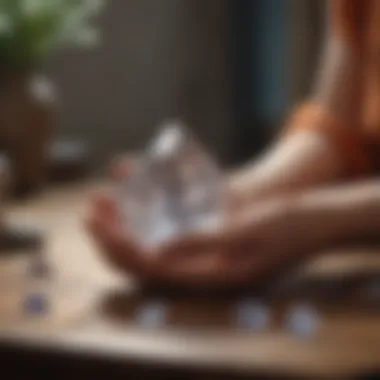
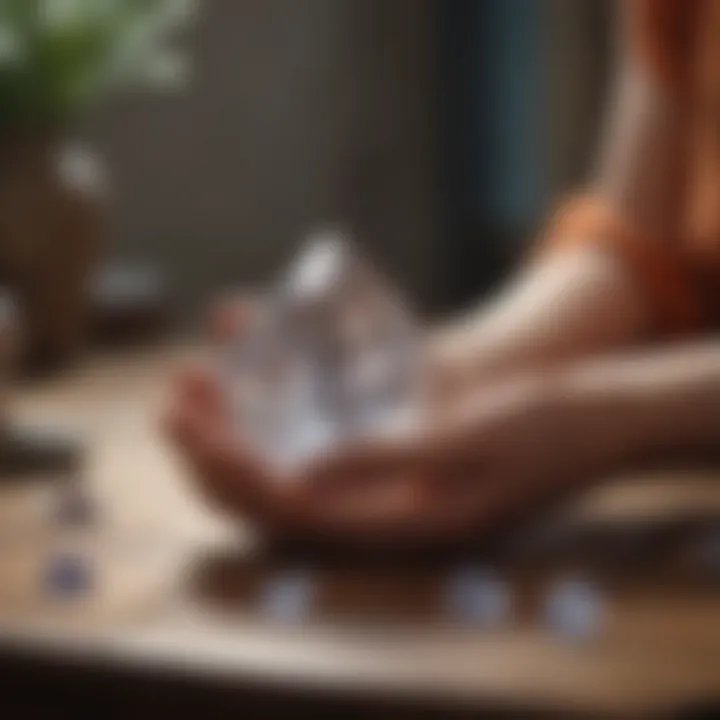
Coping with Anxiety Through Crystals
Anxiety can be a daunting shadow, creeping in when least expected. Here, crystals enter the frame as potential allies for coping strategies. Many advocates often turn to citrine or black tourmaline for their reputed calming effects. The thinking is that these stones can act as grounding tools, helping to redirect negative energy into something more manageable.
Using crystals in combination with mindfulness practices may enhance their efficacy. For example, a person might hold a rose quartz during deep breathing exercises, envisioning the crystal absorbing anxious energy. This practice mirrors the concept of visualization often embraced in therapeutic settings. While personal narratives abound, scientific studies about their actual effectiveness remain sparse.
Identifying Suitable Crystals for Mood Enhancement
Not every crystal is suited for every individual, and it’s crucial to find the right gems to serve specific emotional needs. A few often recommended crystals for mood enhancement include:
- Citrine: Said to bring joy and positivity.
- Lepidolite: Often associated with tranquility and balance, helpful in mood swings.
- Smoky Quartz: Believed to detoxify negative energy.
- Amazonite: Known for promoting calmness and peace.
Choosing the right crystal could vary based on personal resonance with the stone. One approach might involve visiting local crystal shops, where one can physically touch and feel the energy of various stones. Listen to one’s intuition; many folks report a physical sense of connection to certain stones, which can provide clues about their suitability.
Exploring crystals for emotional healing opens a door to personal exploration. It encourages individuals to engage with their inner selves, seeking what resonates to foster overall mental wellness. While the conversation around crystal healing often attracts skepticism, the subjective experiences of many cannot be overlooked. Whether one’s interest lies in practical applications or simply curiosity, there’s much to ponder in this fascinating intersection of minerals and mental health.
The Use of Crystals in Therapeutic Settings
The application of crystals within therapeutic frameworks has gained traction among mental health practitioners and enthusiasts alike. Their use in these settings is not just an interesting fad; rather, they represent a synthesis of ancient practices and contemporary psychological insights. Integrating crystals into therapy offers a multi-faceted approach to well-being, providing tangible benefits alongside more traditional psychological methods.
Crystals can potentially enhance the therapeutic environment. Some therapists incorporate these stones into sessions to cultivate a sense of calmness and safety. The presence of a crystal can create a more hospitable atmosphere, encouraging clients to open up about their struggles and emotions. This gentle provocation of emotional discussion facilitates healing and recovery.
Integration into Psychotherapy
In psychotherapy, crystal use can be more than just a decorative flourish. It is increasingly recognized for its potential to aid sessions emotionally and spiritually. Consider the use of rose quartz, often thought of as the stone of love, warmth, and emotional healing. When placed within the therapy room, this crystal may invoke feelings of self-acceptance and compassion.
Integrating crystals into psychotherapy requires thoughtful consideration. Here are a few key points to keep in mind:
- Choosing the Right Crystal: Each stone carries unique purported properties. A therapist might use amethyst for its calming effects during anxiety management sessions, while citrine may be suggested for empowerment and motivation.
- Encouraging Personal Connections: Clients can be engaged in selecting a crystal that resonates with them. This personal element cultivates deeper involvement in their healing process.
- Setting Intention: Clients may be encouraged to set intentions related to their crystal use, reinforcing focus during therapy sessions. This practice aligns well with mindfulness techniques.
"The use of crystals in therapeutic settings is a bridge between ancient wisdom and modern psychological practice, fostering deeper connections between the therapist and the client."
Crystal Healing Practices
Crystal healing practices often extend well beyond the therapeutic dialogue, delving into the realm of holistic approaches to mental health. This practice involves placing crystals on or around a person’s body to encourage healing on multiple levels. Various techniques inspire individuals to connect with the energetic properties of their chosen crystals, promoting both mental and emotional wellness.
- Grounding Techniques: Some practitioners employ grounding techniques using crystals. This could involve lying down and placing larger stones at the feet to create stability, while smaller stones may be used on the heart chakra—situated in the center of the chest—to enhance emotional clarity.
- Visualization Practices: During guided meditations, different crystals can be held or placed nearby to help with visualization. For example, a practitioner might suggest holding a piece of labradorite while envisioning a protective barrier surrounding the individual, warding off negativity.
- Combining with Aromatherapy: Some practices blend crystal healing with aromatherapy. The scents of essential oils, paired with the energetic attributes of crystals like selenite, can aid in calming down the nervous system, enhancing the overall effect.
Incorporating crystals into therapeutic settings is about creating a holistic environment where clients feel supported and empowered. The stones are not seen as replacements for traditional healing methods but rather as complementary tools, enhancing the journey towards emotional resilience and mental clarity.
Scientific Examination of Crystals' Effects
The investigation of crystals' role in mental health pushes boundaries. It serves as a bridge between ancient practices and modern science. Understanding how crystals might affect well-being can paint a more rounded picture of their usage, opening the door to mixed methodologies. This section sheds light on research endeavors and critical voices within the field. This balanced approach helps demystify the topic, considering both the appealing allure of crystals and the need for scientific rigor.
Research on Crystals and Well-Being
Many studies have started looking into how crystals might correlate with emotional states and mental well-being. For instance, certain stones like amethyst are often praised for their calming effects, which have led to small-scale investigations into their impact on job-related stress. Participants in several pilot studies reported feeling more relaxed and focused when near these stones. Emerging studies hint that vibrations from crystals may catalyze positive interaction with the body's energy fields.


Some researchers caution readers that the evidence is mostly anecdotal. They point out that the observed effects could stem from the placebo phenomenon. Still, The following elements present interesting insights into the ways crystals influence mental well-being:
- Mindfulness and Intention: People often use crystals during meditation, reinforcing their focus and intention. This can lead to an increased sense of well-being.
- Breath and Vibration: There're theories that propose how the vibrational frequencies emitted by crystals interact with human energy fields. Some find these frequencies soothing, possibly creating a tranquil atmosphere.
- Personal Experience: Survey results show that many users swear by their crystals, attributing reduced anxiety to their presence. Importantly, personal testimonies can often be a driving force for further examination.
Skeptical Perspectives
Scholarly skepticism is a key component in the scientific discourse surrounding crystals. Critics argue that while crystals are visually stunning, the evidence supporting their efficacy remains shaky. They contend that the perceived benefits could arise from factors such as confirmation bias or a simple desire for comfort in the chaotic landscape of daily life.
Specific challenges raised include:
- Lack of Empirical Evidence: Many studies lack rigorous methodologies or sufficient sample sizes. So, critics encourage larger, well-controlled studies to validate any claims.
- Psychological Interpretations: Mental health professionals often suggest that any positive experiences linked to crystals may relate more to psychological associations than to intrinsic properties of the stones. The power of belief plays an undeniably crucial role in the outcomes reported by users.
- Misleading Marketing: The growing popularity of crystals has led to commercial interests, which some say has clouded judgment. This commercialization can often blur the lines between genuine therapeutic benefits and mere marketing hype.
"The true power of crystals lies not in their form but in the stories we weave around them and the intentions we set when we engage with them."
Practical Applications of Crystals in Daily Life
Crystals have long held a special place in various practices, extending beyond aesthetic enjoyment and into more profound areas such as mental health management. Their use in daily routines can potentially provide numerous benefits, enhancing emotional well-being and creating a more harmonious life. Integrating crystals into your day-to-day activities isn't just trendy; it can have tangible effects on your mental state when approached with intention and awareness.
Creating a Crystal Routine for Mental Health
Establishing a crystal routine is an individualized process. Each person may resonate differently with various stones, and it’s important to find what works best for you. Start by selecting a few crystals that align with your specific emotional needs. For instance, amethyst is often recommended for its calming properties, while rose quartz can foster feelings of love and compassion.
- Morning Ritual: Consider starting your day by holding your chosen crystal during morning meditation. This can ground your thoughts, centering you before the day unfolds. Spend a few moments visualizing your intentions while engaging with the stone.
- Midday Check-In: As the day rolls on, emotions can swirl and twist. Take a moment during lunchtime to reconnect with your crystal. Carrying a small stone in your pocket or wearing jewelry made from crystals can serve as a reminder to stay mindful and present.
- Evening Reflection: At day’s end, take time to reflect on your day paired with your crystal. You could write in a journal, placing the crystal next to your notes, allowing its energy to infuse your thoughts with clarity.
Adapting your crystal routine can take time, so remain open to adjustments based on how you feel. Pay attention to your moods, and let the stones guide you on the path toward improved mental health.
Incorporating Crystals into Meditation Practices
Meditation is another effective space where crystals can enhance your experience. Including crystals in your meditation practice can bring an additional layer of focus and intention. Here’s how to do this effectively:
- Choosing Your Stone: Select a crystal that corresponds with your meditation goals. If you seek tranquility, consider sodalite; if clarity is your aim, perhaps clear quartz fits the bill.
- Physical Placement: During meditation, lay down your crystal on the area just above your heart, or hold it in your hands. The physical connection can create a sense of grounding as you enter a meditative state.
- Visualization: Visualize the crystal's energy expanding from the stone and surrounding you in a protective bubble. This mental imagery can help in establishing a deeper connection to the stone as you breathe deeply and align with its vibrations.
"Crystals, much like thoughts, need to be nurtured and cared for to reveal their full potential."
- Focus on Breath: During your practice, if your mind starts to wander, gently return your focus to the sensation of the crystal in your hands or against your body. Imagine any negative energies being absorbed by the stone, allowing for a more serene mental state.
By weaving crystals into your meditation, you're not just using them as decorative pieces but as tools for introspection and emotional healing.
End and Future Directions
As we close the discussion on the intersection of crystals and mental health, it is clear that this relationship holds both intrigue and potential. The exploration of such alternative therapies can empower individuals seeking effective ways to manage their mental and emotional well-being. Understanding that crystals are not just visually appealing objects but are also believed to harbor unique properties adds another layer to their significance.
Summary of Key Insights
To sum it all up, several key insights emerged throughout the article regarding the impact of crystals on mental health:
- Historical Context: Crystals have a storied past across various cultures, suggesting they were valued for their healing properties long before modern medicine took the stage. Ancient civilizations believed that gemstones could influence emotional states and provide protection.
- Variety of Properties: Crystals possess not only physical attributes but also metaphysical ones. These properties can supposedly interact with human energy fields, making them tools for emotional healing and stress relief. Some specific crystals are known for their abilities to alleviate anxiety or enhance mood, and the right choice often depends on individual needs.
- Therapeutic Integration: As the wellness industry continues to evolve, therapists have started incorporating crystals into their practices, blending traditional psychological methods with contemporary holistic approaches. This fusion could appeal to people who are open to alternative therapies.
- Scientific Scrutiny: Not everyone is convinced about the efficacy of crystals in psychological healing. Scientific studies remain mixed, prompting further dialogue and examination into how, or if, these practices truly benefit mental health.
Potential for Further Research
The future direction of studying the effects of crystals on mental health is promising. Potential research pathways could include:
- Controlled Studies: More robust scientific studies can provide clarity on how crystal healing might influence psychological states. Randomized controlled trials could yield vital data to validate anecdotal experiences.
- Longitudinal Research: Understanding the long-term effects of using crystals for mental health can lead to insights about their enduring impacts and any necessary cautions.
- Cultural Differences: Exploring how different cultures incorporate crystals can illuminate varying beliefs and usages. This could allow for a broader understanding of how crystals function across diverse psychological frameworks.
- Technological Integration: As technology advances, so too does the potential for innovative ways to study the energies of crystals. With tools like biofeedback sensors, we may uncover how crystal energy interacts with human physiology.
- Interdisciplinary Studies: Collaboration between psychologists, geologists, and spiritual practitioners can yield fruitful discussions and research endeavors that may offer a more comprehensive understanding of how crystals can be used effectively in mental health strategies.
In summary, as interest in mental health alternatives continues to flourish, an in-depth exploration into the role of crystals can unearth valuable insights. Both scientific inquiry and personal testimonies will be necessary for a balanced view, helping to bridge the gap between skepticism and enthusiasm. Crystals might be more than pretty stones; they could become significant allies in the journey toward improved mental wellness.



